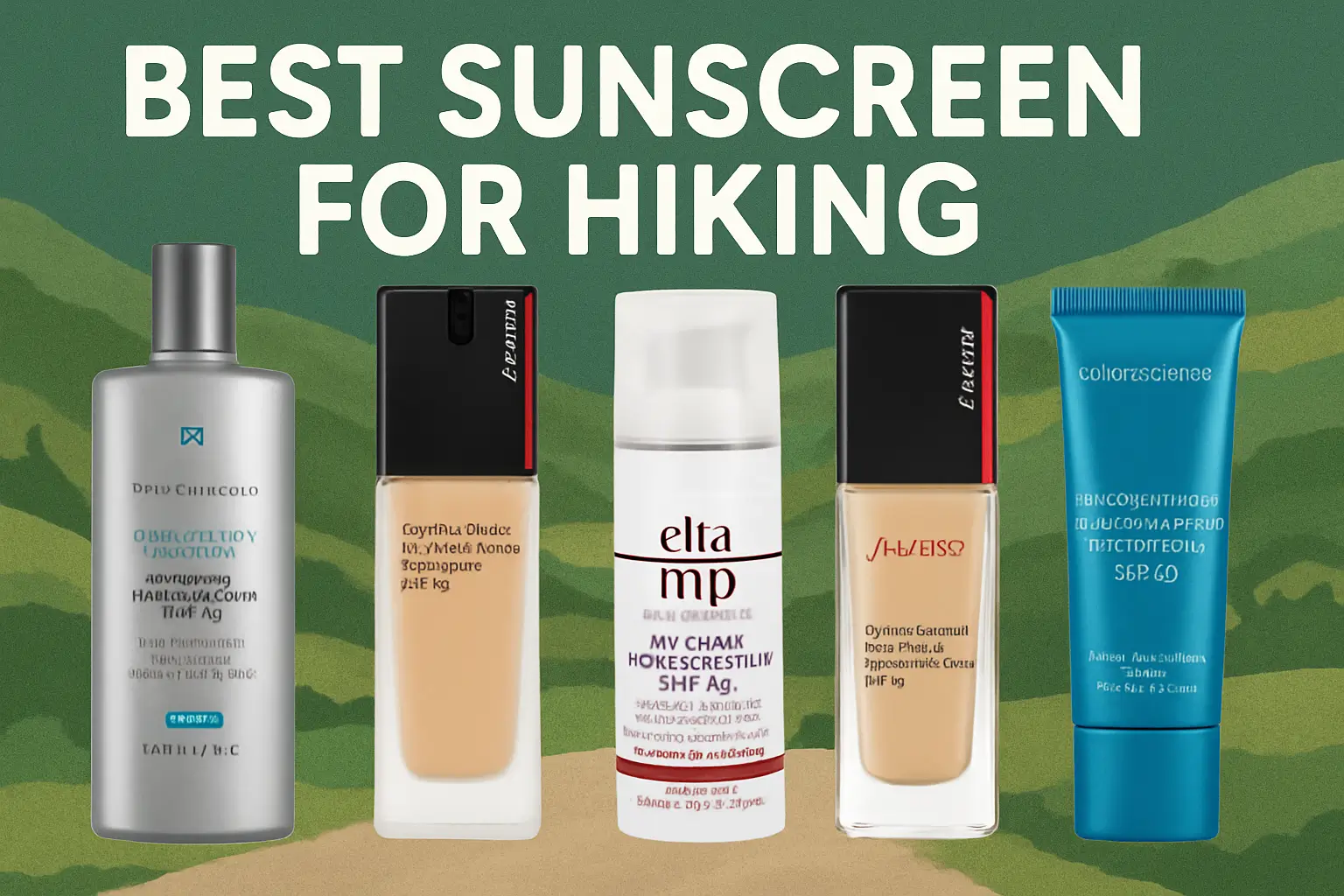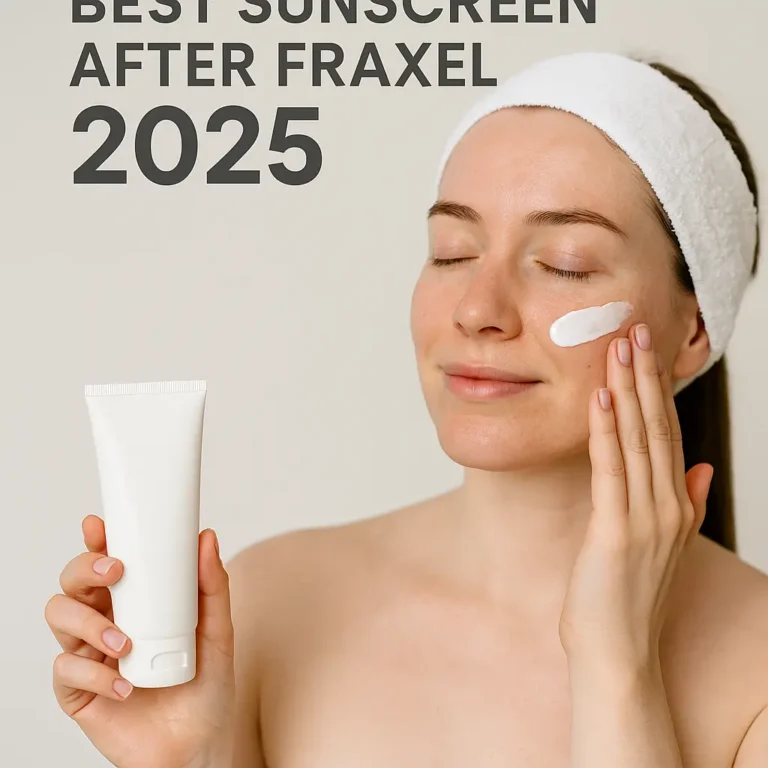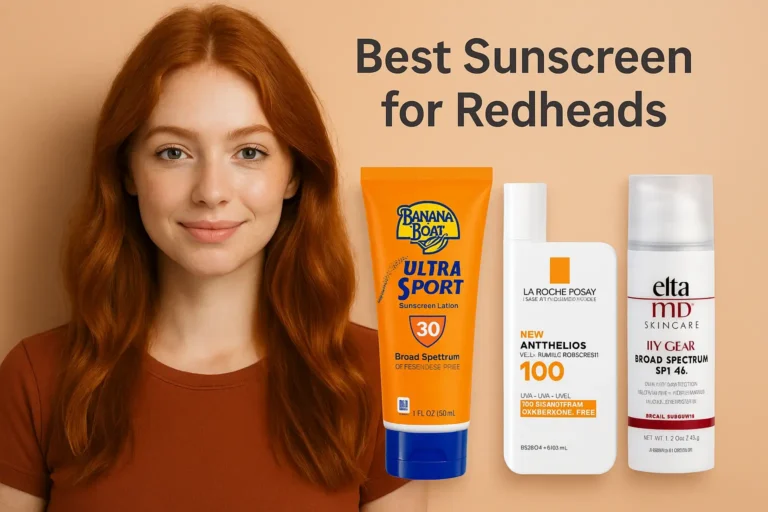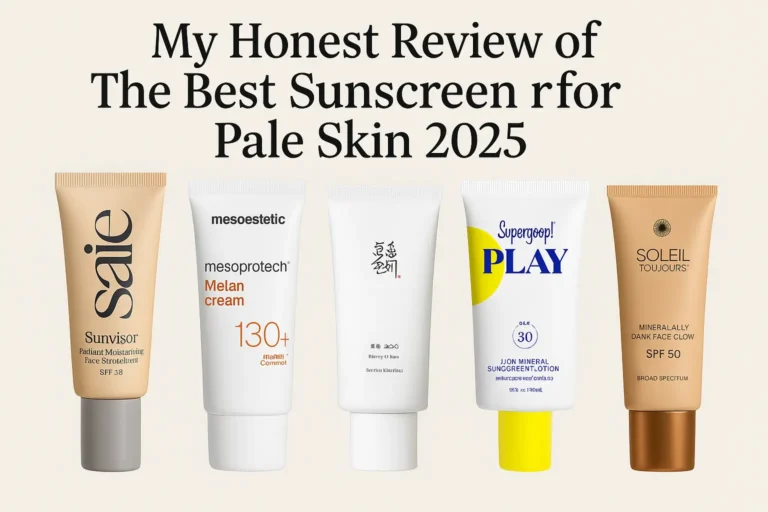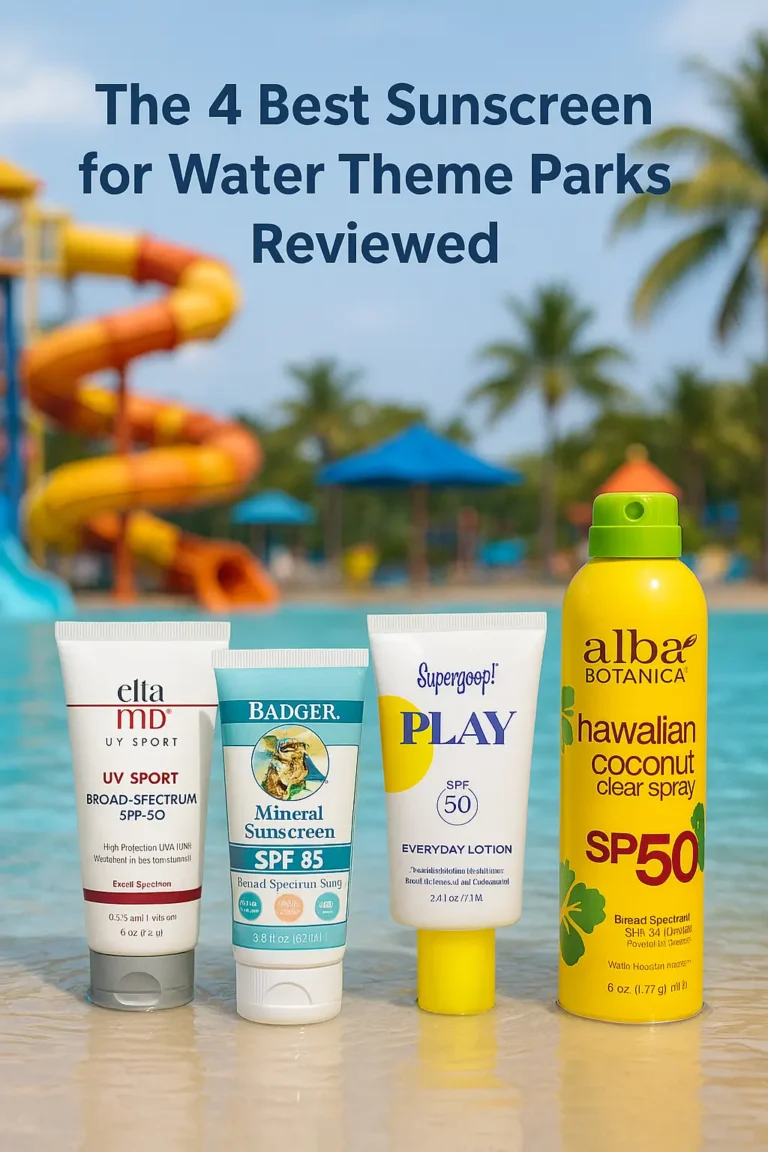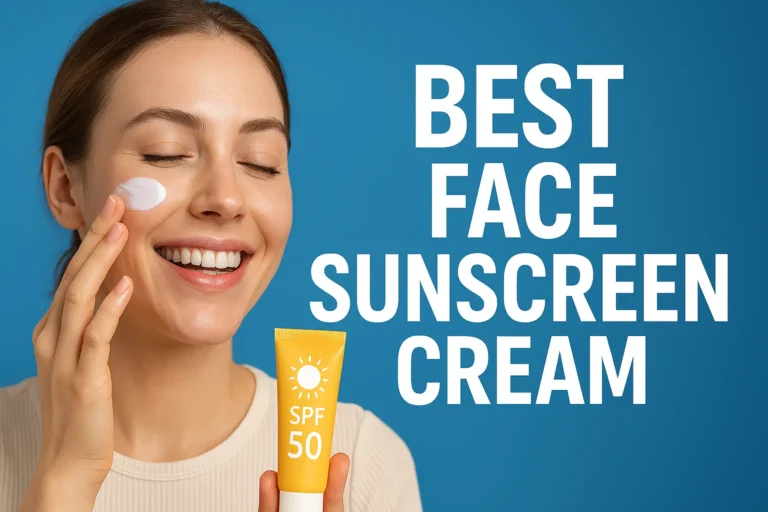Review of The 5 Best Sunscreen for Hiking
Table of Contents
Hikers Need Specialized Sun Protection
When you’re conquering mountain trails or exploring desert landscapes, regular sunscreen just doesn’t cut it. The best sunscreen for hiking needs to withstand sweat, provide long-lasting protection at high altitudes, and maintain effectiveness through hours of outdoor exposure. Unlike your daily facial SPF, hiking sunscreens face extreme conditions—intense UV rays, wind, perspiration, and the need for frequent reapplication in remote locations.
Finding the best sunscreen for hiking isn’t just about SPF numbers. You need formulations that won’t sting your eyes when you sweat, won’t slide off during strenuous climbs, and can handle the unique challenges of extended outdoor adventures. Whether you’re tackling day hikes or multi-day backpacking trips, the right sun protection can make the difference between an enjoyable outdoor experience and painful sunburns that ruin your adventure.
In this comprehensive guide, I’ll break down exactly what makes the best sunscreen for hiking, review the top-performing products specifically tested for outdoor activities, and help you choose the perfect protection for your trail adventures. From budget-friendly options to premium formulations, we’ll cover everything you need to know to stay protected on the trails.
What Makes the Best Sunscreen for Hiking Different?
Before diving into specific product recommendations, let’s understand what separates the best sunscreen for hiking from regular daily-use formulas:
Essential Features for Trail-Ready Protection
Superior Water and Sweat Resistance The best sunscreen for hiking must maintain effectiveness even when you’re sweating heavily during strenuous climbs. Look for products with 80-minute water resistance ratings and formulations specifically designed for athletic activities.
High SPF with Broad-Spectrum Protection At higher altitudes, UV exposure increases significantly—about 4% for every 1,000 feet of elevation gain. The best sunscreen for hiking should offer SPF 30 minimum, with SPF 50+ recommended for high-altitude adventures and extended sun exposure.
Non-Comedogenic and Eye-Safe Formulations Nothing ruins a hike like sunscreen stinging your eyes or causing breakouts under your backpack straps. The best sunscreen for hiking won’t migrate into sensitive areas or clog pores during extended wear.
Easy Application and Reapplication On the trail, you need products that apply quickly and evenly without requiring extensive rubbing. The best sunscreen for hiking should be packable, mess-free, and suitable for reapplication even with dusty or slightly damp hands.
Temperature Stability Trail conditions vary dramatically—from cold morning starts to blazing afternoon sun. The best sunscreen for hiking maintains consistency and effectiveness across temperature extremes without becoming too thick or too runny.
Special Considerations for Different Hiking Environments
Desert and High-Altitude Hiking These environments demand the most robust protection. The best sunscreen for hiking in these conditions requires maximum SPF, superior photostability, and formulations that won’t evaporate or degrade in intense heat and UV exposure.
Forest and Shaded Trails Even in partially shaded environments, reflected UV from rocks, snow, or water can cause burns. The best sunscreen for hiking should protect against these indirect exposures while being comfortable for all-day wear.
Multi-Day Backpacking For extended trips, the best sunscreen for hiking needs to be packable, long-lasting, and effective even when applied over previously applied layers or slightly dirty skin.
Best Sunscreen for Hiking: Top 5 Products Reviewed
Now let’s examine the best sunscreen for hiking options, each tested and proven effective for serious outdoor enthusiasts:
1. SkinCeuticals Physical Fusion UV Defense Sunscreen Broad Spectrum SPF 50

Best Overall Sunscreen for Hiking
Key Features:
- 100% mineral sunscreen with zinc oxide and titanium dioxide
- SPF 50 broad-spectrum protection
- Universal tint that works on multiple skin tones
- Antioxidant protection from artemia salina extract
- Water-resistant for 40 minutes
Why It’s the Best Sunscreen for Hiking: SkinCeuticals Physical Fusion delivers medical-grade protection in a formula that performs exceptionally well on the trails. The mineral-based protection won’t break down under intense UV exposure, making it ideal for high-altitude hiking where chemical sunscreens might degrade.
Pros:
- Provides immediate protection upon application
- Minimal white cast thanks to the universal tint
- Excellent for sensitive skin and those prone to chemical sunscreen reactions
- Won’t sting eyes when you sweat
- Photostable formula maintains effectiveness throughout long hiking days
Cons:
- Higher price point than drugstore alternatives
- Requires more thorough blending than chemical formulas
- 40-minute water resistance is lower than some athletic-specific products
Texture & Trail Performance: This cream blends to a natural, slightly matte finish that helps control shine during strenuous activities. The tint eliminates the ghostly appearance common with mineral sunscreens, making it practical for photos at scenic viewpoints.
Best For: Day hiking, sensitive skin, high-altitude adventures, hikers who prioritize ingredient safety and photostability.
Available at Ecosmetics
2. Shiseido Synchro Skin Self-Refreshing Foundation SPF 30 PA++++

Best Multitasking Sunscreen for Hiking
Key Features:
- Hybrid sunscreen-foundation with SPF 30
- Self-refreshing technology that activates with heat and humidity
- 24-hour hydration and coverage
- Available in multiple shades
- Oil-free, transfer-resistant formula
Why It’s Among the Best Sunscreen for Hiking: Shiseido’s innovative self-refreshing technology makes this unique among hiking sunscreens—it actually becomes more effective as you heat up and sweat, making it perfect for strenuous trail conditions.
Pros:
- Provides both sun protection and natural coverage for an even complexion
- Self-refreshing formula gets better as you sweat
- Excellent shade range for different skin tones
- Long-wearing without touch-ups
- Comfortable for all-day wear
Cons:
- Lower SPF than dedicated outdoor sunscreens
- Foundation aspect may not appeal to all hikers
- Higher price point
- May be too much coverage for some outdoor enthusiasts
Texture & Trail Performance: Lightweight and breathable with a natural finish that looks like enhanced skin rather than makeup. The self-refreshing technology means it maintains coverage and protection even during challenging climbs.
Best For: Hikers who want coverage plus protection, day hikes with social elements, those who prefer multitasking products, hikers with uneven skin tone.
Available at Ecosmetics
3. EltaMD UV Clear Broad-Spectrum Sunscreen SPF 46

Best Sunscreen for Hiking with Sensitive or Acne-Prone Skin
Key Features:
- Zinc oxide and octinoxate protection
- Oil-free, sensitivity-free formula
- Contains niacinamide for skin benefits
- Fragrance-free and paraben-free
- Suitable for all skin types including rosacea-prone
Why It’s the Best Sunscreen for Hiking Sensitive Skin: EltaMD UV Clear is dermatologist-developed specifically for problematic skin that reacts to typical sunscreen ingredients. The addition of niacinamide provides anti-inflammatory benefits perfect for wind and sun-exposed hiking skin.
Pros:
- Extremely gentle formula suitable for the most sensitive skin
- Niacinamide helps calm and protect skin
- Goes on completely clear with no white cast
- Non-comedogenic won’t cause breakouts under backpack straps
- Fragrance-free won’t attract insects
Cons:
- Contains octinoxate, which some prefer to avoid
- Can feel slightly sticky until fully absorbed
- More expensive than drugstore alternatives
- May not provide enough moisture for very dry skin
Texture & Trail Performance: Lightweight lotion consistency that absorbs to a natural finish. Works excellently under sun hats and with hiking gear without pilling or sliding.
Best For: Sensitive skin, acne-prone hikers, those with rosacea, hikers who react to fragranced products, anyone needing gentle but effective protection.
Available at Ecosmetics
4. Shiseido Revitalessence Skin Glow Foundation SPF 30 PA+++

Best Illuminating Sunscreen for Hiking
Key Features:
- Lightweight foundation with SPF 30 protection
- Skin-perfecting coverage with natural glow
- Hydrating formula with skincare benefits
- Multiple shade options
- Long-wearing, transfer-resistant
Why It Makes the Best Sunscreen for Hiking List: For hikers who want to look polished while protected, this foundation-sunscreen hybrid provides natural coverage with a healthy glow that’s perfect for outdoor adventures and trail photography.
Pros:
- Creates a natural, healthy-looking glow
- Provides even coverage for skin imperfections
- Comfortable for extended wear
- Good shade selection
- Hydrating without being heavy
Cons:
- Lower SPF than dedicated outdoor sunscreens
- May be too much for minimalist hikers
- Foundation aspect requires more careful application
- Premium price point
Texture & Trail Performance: Creamy, blendable texture that creates a natural “your skin but better” finish. The glow effect is subtle and natural-looking, not artificial or glittery.
Best For: Day hikes with social components, hikers who prefer multitasking products, those who like light coverage, photographers who want to look good in trail photos.
Available at Ecosmetics
5. Colorescience Sunforgettable Total Protection Face Shield Flex SPF 50

Best Stick Sunscreen for Hiking
Key Features:
- Convenient stick format with SPF 50 protection
- 100% mineral with zinc oxide and titanium dioxide
- Water and sweat resistant for 80 minutes
- Antioxidant protection with iron oxides
- Travel-friendly and mess-free application
Why It’s the Best Sunscreen for Hiking Convenience: The stick format makes Colorescience Sunforgettable the ultimate hiking companion—no mess, no spills, easy reapplication even with dirty hands, and TSA-friendly for hiking trips that involve air travel.
Pros:
- Ultimate convenience for trail application and reapplication
- No mess or spillage in your pack
- Full mineral protection that won’t break down
- 80-minute water resistance perfect for sweaty hikes
- Works great for targeted application on nose, ears, and shoulders
Cons:
- Can feel waxy if overapplied
- More expensive per ounce than liquid formulas
- Requires warming up in cold conditions
- May leave slight white cast if not blended well
Texture & Trail Performance: Solid stick that glides on smoothly when warmed. Becomes transparent when worked into skin and provides a matte finish that helps control shine.
Best For: Backpackers, frequent reapplication, travel, targeted protection, hikers who prioritize convenience, anyone who struggles with liquid sunscreen application on the trail.
Available at Ecosmetics
Mineral vs. Chemical: Which Is the Best Sunscreen for Hiking?
Understanding the difference between mineral and chemical sunscreens helps you choose the best sunscreen for hiking based on your specific needs and hiking conditions.
Mineral Sunscreens for Hiking
How They Work: Mineral sunscreens (zinc oxide and titanium dioxide) sit on top of skin and physically block UV rays.
Advantages for Hiking:
- Immediate protection upon application
- Won’t break down in intense UV or high temperatures
- Less likely to cause skin reactions or eye stinging
- More environmentally friendly
- Photostable across all conditions
Challenges for Hiking:
- Can leave white cast, especially when reapplying over sweaty skin
- May feel heavier or more noticeable
- Can be harder to blend thoroughly on the trail
- Generally more expensive
Best Hiking Situations for Mineral: High-altitude hiking, sensitive skin, extended exposure, environmentally sensitive areas, any situation where you need guaranteed protection that won’t degrade.
Chemical Sunscreens for Hiking
How They Work: Chemical sunscreens absorb UV rays and convert them to heat, which is then released from the skin.
Advantages for Hiking:
- Lighter, more elegant textures
- Easier to apply and reapply
- No white cast issues
- Generally more affordable
- Better under hiking clothing
Challenges for Hiking:
- May break down under intense UV exposure
- Can sting eyes when mixed with sweat
- Some ingredients may cause reactions
- Takes 15-20 minutes to become fully effective
Best Hiking Situations for Chemical: Lower-altitude day hikes, when cosmetic elegance is important, for hikers with no skin sensitivities, situations requiring frequent reapplication.
The Verdict: Best Sunscreen for Hiking Type
For most serious hiking applications, mineral sunscreens edge out as the best sunscreen for hiking due to their reliability under extreme conditions. However, the best approach might be using both: mineral for initial application and key areas (face, nose, shoulders), and chemical for easy reapplication on body areas.
Application Tips: Getting the Most from the Best Sunscreen for Hiking
Even the best sunscreen for hiking won’t protect you if it’s not applied correctly. Here’s how to maximize your protection on the trails:
Pre-Hike Application Strategy
15-30 Minutes Before Starting: Apply your chosen sunscreen liberally 15-30 minutes before beginning your hike. This allows chemical sunscreens to activate and gives mineral formulas time to settle into your skin properly.
Amount Matters: Use approximately 1 ounce (2 tablespoons) to cover your entire body. For your face alone, use about 1/4 teaspoon. Most people use far less than needed, reducing effectiveness significantly.
Don’t Forget These Areas:
- Ears and ear tips
- Back of neck
- Feet if wearing open hiking shoes
- Hands and backs of hands
- Lips (use SPF lip balm)
- Scalp if not wearing a hat
Trail Reapplication Techniques
Every 2 Hours Minimum: The best sunscreen for hiking still needs reapplication every 2 hours, or more frequently if you’re sweating heavily or swimming.
After Heavy Sweating: Even water-resistant formulas need refreshing after particularly strenuous climbs or during hot weather hiking.
Layer-Friendly Reapplication: Apply over existing layers rather than trying to remove previous applications. The best sunscreen for hiking should layer well without pilling or becoming thick.
Weather-Specific Application Tips
High Altitude Hiking: UV exposure increases 4% for every 1,000 feet of elevation. Apply more liberally and reapply more frequently above 8,000 feet.
Snow and Reflective Conditions: Snow reflects up to 80% of UV rays. The best sunscreen for hiking in winter conditions requires more frequent application to exposed areas and extra attention to often-forgotten spots like under the nose and chin.
Hot Weather Hiking: In extreme heat, some sunscreens may become runny. Store your backup applications in the coolest part of your pack and consider stick formulas for reliability in high temperatures.
Special Considerations for Different Types of Hiking
The best sunscreen for hiking varies depending on your specific outdoor adventures. Here’s how to choose based on your hiking style:
Day Hiking Sunscreen Needs
Characteristics Required:
- Comfortable for 6-12 hours of wear
- Easy reapplication for lunch breaks and rest stops
- Cosmetically elegant for potential social interactions
- Packable but not necessarily ultralight
Best Options: SkinCeuticals Physical Fusion or EltaMD UV Clear work excellently for day hiking, providing reliable protection without the need for ultralight formulations.
Backpacking and Multi-Day Hiking
Characteristics Required:
- Packable and lightweight
- Effective over multiple days of application
- Durable containers that won’t leak or break
- Multi-purpose if possible
Best Options: Colorescience stick format excels for backpacking due to mess-free application and durability. Consider bringing both a stick for face/targeted areas and a lightweight tube for body coverage.
High-Altitude and Alpine Hiking
Characteristics Required:
- Maximum SPF protection
- Photostable ingredients that won’t degrade
- Effective in cold temperatures
- Resistant to wind and extreme conditions
Best Options: Mineral formulations like SkinCeuticals Physical Fusion provide the most reliable protection at altitude where UV exposure is most intense.
Desert Hiking
Characteristics Required:
- Heat-stable formulations
- Superior sweat resistance
- Protection against reflected UV from sand and rocks
- Long-lasting effectiveness in extreme heat
Best Options: Products with 80-minute water resistance like Colorescience Sunforgettable perform best in desert conditions where sweating is inevitable.
Water-Adjacent Hiking
Characteristics Required:
- Maximum water resistance
- Protection against reflected UV from water surfaces
- Quick-drying if you get splashed
- Effective even when damp
Best Options: Look for formulas specifically labeled for aquatic activities with 80-minute water resistance ratings.
Budget vs. Premium: Finding the Best Sunscreen for Hiking Value
While our top 5 list focuses on premium options, let’s address how to find the best sunscreen for hiking at different price points:
Premium Options
When to Invest:
- Frequent hiking (multiple times per month)
- Extended trips or challenging conditions
- Sensitive skin that reacts to cheaper formulations
- Professional or serious amateur hiking
Benefits of Premium:
- Superior formulations and testing
- Better cosmetic elegance
- Specialized features for outdoor activities
- Often more effective and longer-lasting
Mid-Range Options
Sweet Spot Characteristics:
- Good protection without premium pricing
- Suitable for regular hikers
- Balance of effectiveness and affordability
- Often include some specialized outdoor features
Budget-Friendly Alternatives
When Budget Options Work:
- Occasional hiking
- Less challenging conditions
- Non-sensitive skin
- Supplemental protection alongside other measures
What to Look For:
- Broad-spectrum SPF 30+
- Water resistance rating
- Established brand with testing
- Larger sizes for better per-ounce value
Common Mistakes That Reduce Sunscreen Effectiveness
Even with the best sunscreen for hiking, these common errors can leave you burned:
Application Mistakes
Not Using Enough Product: The single biggest mistake hikers make. Most people use 25-50% of the recommended amount, significantly reducing protection.
Incomplete Coverage: Missing easy-to-forget areas like ears, feet, and the back of hands. Make a mental checklist or use a buddy system.
Poor Timing: Applying sunscreen in the parking lot right before hitting the trail doesn’t allow proper activation time.
Reapplication Errors
Skipping Reapplication: Thinking one morning application will last all day, regardless of conditions or activity level.
Inadequate Reapplication: Dabbing a tiny amount instead of properly refreshing coverage, especially after sweating heavily.
Wrong Timing: Waiting until you feel warm or see redness before reapplying—by then, damage has already occurred.
Storage and Handling Mistakes
Extreme Temperature Storage: Leaving sunscreen in hot cars or freezing conditions can change consistency and reduce effectiveness.
Using Expired Products: Sunscreen loses effectiveness over time. Check expiration dates and replace old products.
Cross-Contamination: Using the same product for face and body without considering different skin needs and sensitivities.
Environmental Impact: Choosing Eco-Friendly Hiking Sunscreen
As outdoor enthusiasts, choosing the best sunscreen for hiking should also consider environmental impact:
Reef-Safe Ingredients
Avoid These Ingredients:
- Oxybenzone
- Octinoxate
- Octocrylene (in some formulations)
- Homosalate (in high concentrations)
Preferred Ingredients:
- Zinc oxide (non-nano preferred)
- Titanium dioxide
- Avobenzone (in reef-safe formulations)
Packaging Considerations
Eco-Friendly Options:
- Recyclable containers
- Minimal packaging
- Concentrated formulas requiring less product
- Refillable options where available
Leave No Trace Principles
Application Considerations:
- Apply sunscreen away from water sources
- Choose biodegradable formulas when possible
- Pack out all sunscreen containers
- Consider sun protective clothing to reduce sunscreen need
Frequently Asked Questions About the Best Sunscreen for Hiking
What SPF is best for hiking?
SPF 30 is the minimum recommended for hiking, but SPF 50+ is preferred for extended outdoor exposure, high-altitude hiking, or fair skin. The best sunscreen for hiking balances high protection with practical application—extremely high SPFs (70+) don’t provide proportionally better protection and can be harder to apply evenly.
How often should I reapply sunscreen while hiking?
Reapply every 2 hours minimum, or more frequently if you’re sweating heavily, swimming, or toweling off. The best sunscreen for hiking maintains effectiveness longer, but no sunscreen lasts all day without reapplication, regardless of marketing claims.
Can I use face sunscreen on my body while hiking?
Yes, but it’s often not cost-effective. Face formulas are typically more expensive per ounce and designed for smaller areas. The best approach is using specialized face sunscreen on your face and neck, and body formula elsewhere.
Is waterproof sunscreen better for hiking?
No sunscreen is truly “waterproof”—the FDA requires brands use “water-resistant” with time ratings (40 or 80 minutes). For hiking, 80-minute water resistance is ideal as it better withstands sweat and humid conditions.
Do I need sunscreen on cloudy hiking days?
Absolutely. Up to 80% of UV rays penetrate clouds, and you can still burn on overcast days. The best sunscreen for hiking should be applied regardless of visible sunshine, especially at higher altitudes where UV exposure is more intense.
How much sunscreen should I pack for a multi-day hike?
Plan for approximately 1 ounce per day for full-body coverage, plus extra for frequent reapplication. A 3-ounce tube should last 2-3 days for one person with proper application. The best sunscreen for hiking backpacking trips comes in durable, leak-proof containers.
Can sunscreen expire, and does it matter for hiking?
Yes, sunscreen expires and loses effectiveness over time. Check expiration dates before trips and replace old products. Expired sunscreen may not provide claimed protection levels, making it unreliable for serious hiking conditions.
Should I choose mineral or chemical sunscreen for high-altitude hiking?
Mineral sunscreens are generally better for high-altitude hiking because they don’t break down under intense UV exposure. The best sunscreen for hiking above 8,000 feet is typically a mineral formula with SPF 50+ for maximum reliable protection.
Conclusion: Your Trail to Perfect Sun Protection
Finding the best sunscreen for hiking comes down to matching the right product to your specific needs, skin type, and hiking conditions. Whether you choose the medical-grade protection of SkinCeuticals Physical Fusion, the innovative self-refreshing technology of Shiseido Synchro Skin, the sensitive-skin friendliness of EltaMD UV Clear, the natural glow of Shiseido Revitalessence, or the unbeatable convenience of Colorescience Sunforgettable, each offers distinct advantages for trail protection.
The best sunscreen for hiking is ultimately the one you’ll use consistently and correctly. Consider your typical hiking conditions, skin sensitivity, and personal preferences when making your choice. Remember that proper application and reapplication matter more than any single product feature—even the most advanced formula won’t protect you if it’s not used properly.
As you plan your next outdoor adventure, invest in quality sun protection that matches your hiking ambitions. Your skin will thank you for the protection, and you’ll be able to focus on what matters most—enjoying the incredible experiences that hiking provides. The trails are calling, and now you’re equipped with the knowledge to answer safely and confidently, protected by the best sunscreen for hiking that meets your unique outdoor lifestyle.
Whether you’re tackling your first day hike or preparing for a challenging multi-day backpacking expedition, the right sun protection is an essential piece of gear that deserves the same careful consideration you give to your boots, pack, and other critical equipment. Choose wisely, apply generously, and hit the trails with confidence knowing you’re properly protected for whatever adventures await.
Author’s Top Picks
- The Complete 2025 Guide to The 5 Best Sunscreen for Lupus
- EltaMD UV Clear vs UV Daily
- The 5 Best Sunscreen for Working Outdoors : My Top Picks
- The 5 Best Sunscreen After Fraxel Tested (2025)

